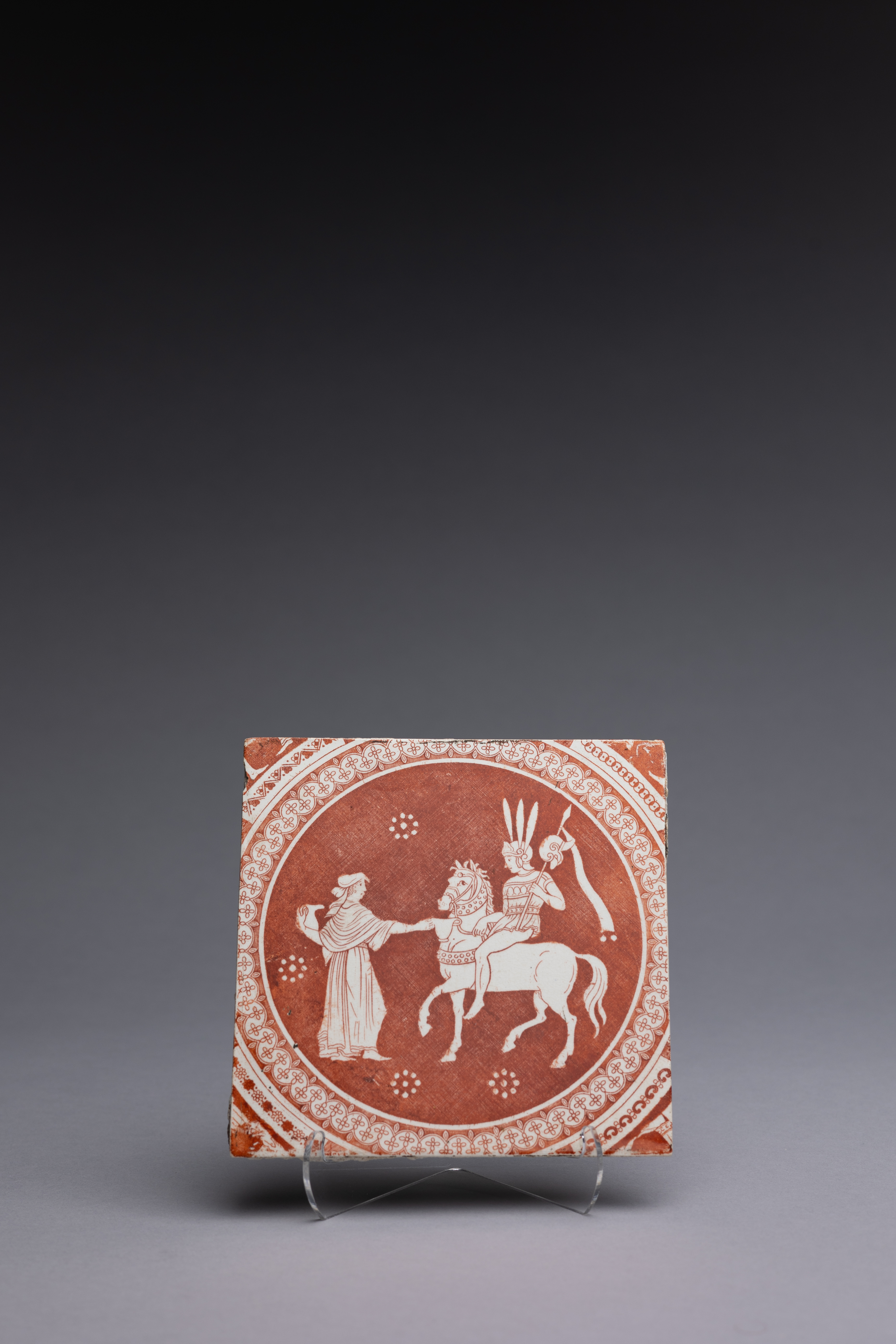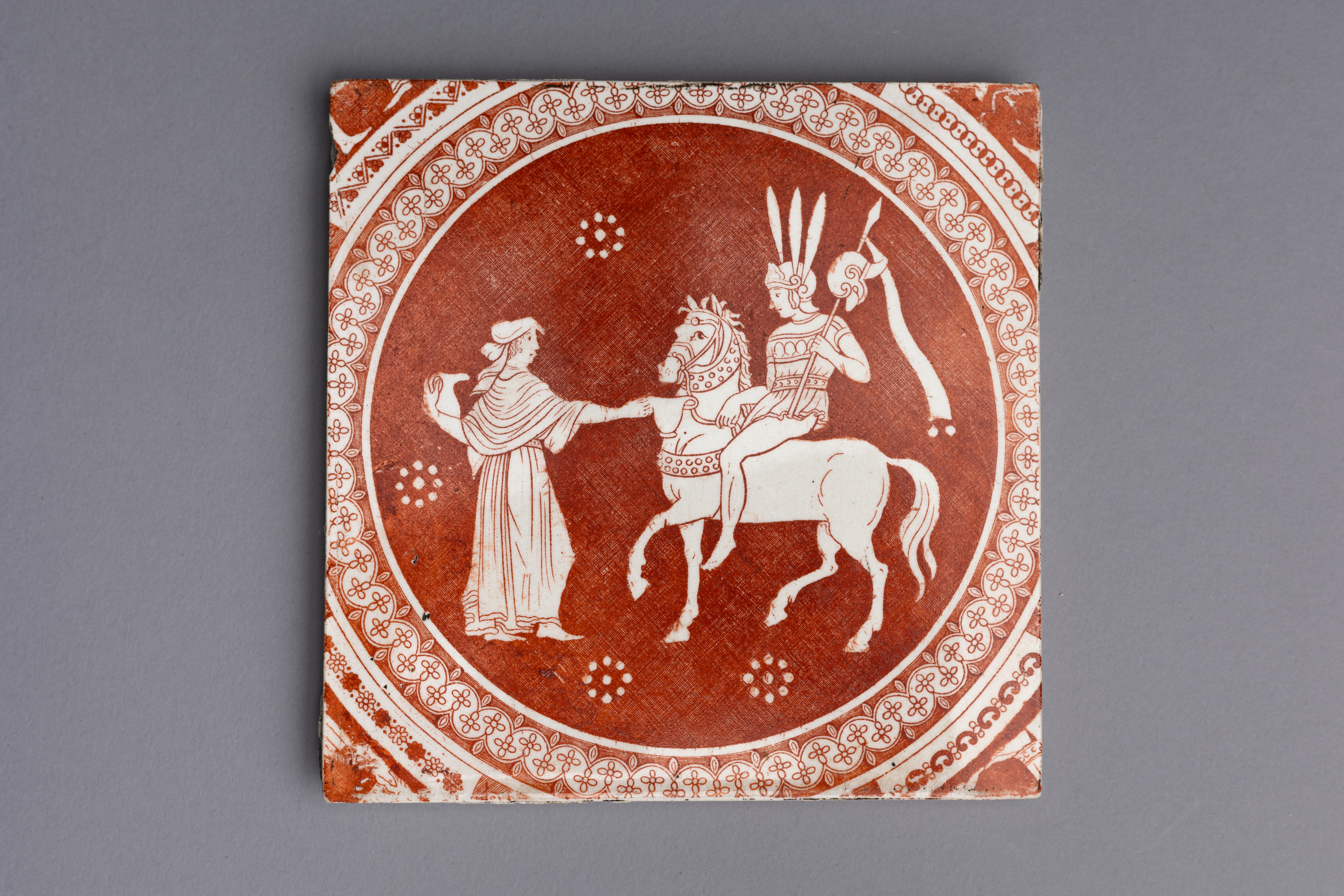Sir William Hamilton’s Collection of Etruscan, Greek and Roman antiquities, first published in 1766 by Pierre d’Hancarville, was a landmark publication in English design. It intended to disseminate the Antique style through its engravings of Attic pottery. The catalog’s faithful reproductions of Classical vases led British potteries, including Spode, to adapt or even copy the ancient art for modern life. These Spode Greek pattern tiles reflect the major influence of Hamilton’s catalog on English Neoclassicism. The central scene was taken directly from the catalog.
Sir William Hamilton’s Collection of Etruscan, Greek and Roman antiquities, first published in 1766 by Pierre d’Hancarville, was a landmark publication in English design. It intended to disseminate the Antique style through its engravings of Attic pottery. The catalog’s faithful reproductions of Classical vases led British potteries, including Spode, to adapt or even copy the ancient art for modern life. These Spode Greek pattern tiles reflect the major influence of Hamilton’s catalog on English Neoclassicism. The central scene was taken directly from the catalog.
“We think also, that we make an agreeable present to our manufacturers of earthenware and china, and to those who make vases in silver, copper, glass, marble etc. Having employed much more time in working than in reflexion, and besides being in great want of models, they will be very glad to find here more than two hundred forms, the greatest part of which are absolutely new to them; then, as in a plentiful stream, they may draw ideas which their ability and taste will know how to improve to their advantage, and to that of the public.”
Pierre d’Hancarville, Collection of Etruscan, Greek and Roman antiquities from the cabinet of the Honourable William Hamilton vol 1 (Naples, 1766) p. xviii.
During the latter half of the eighteenth century, the Neoclassical style developed in England. This style, present in everything from architecture to decorative arts, was largely influenced by the English rediscovery of Antiquity through the Grand Tour and proclaimed a heritage of Western culture, at the time perceived to be the pinnacle of civilization.
Beginning in the seventeenth century and lasting through the nineteenth century, the Grand Tour took the English into the Continent to experience the seat of Western culture in the Italian peninsula. Tourists often had an education in the Classics, which made travel to ancient sites such as Rome and Naples popular. These Classical sites welcomed travelers who in turn picked up inspiration from Antique architecture and artifacts, then brought it back to England to incorporate into new designs. The Antique style was disseminated through publications and catalogs, most notably Sir William Hamilton’s 1766 catalog entitled Collection of Etruscan, Greek and Roman antiquities. Hamilton was the British envoy to Naples and oversaw the excavation of Attic vases, which he then had shipped back to England for placement in the British Museum, where most of them remain today. The collection was compiled into a multi-volume illustrated catalog showing precise replications of the shapes and designs found on these Classical vessels. The major British designers and manufactories owned their own copies of these catalogs, including Wedgwood and Spode. Catalogs were available for acquisition by the aristocracy, however the general public was still exposed to their contents through the designs that were copied onto British ceramics.
This tile, in Spode’s ‘Greek’ pattern, illustrates a scene from Wilhelm Tischbein’s 1791 catalog of the Hamilton collection. In this scene, entitled ‘Refreshments for Phliasian Horseman’, a woman hands a drink to a soldier following Phlius’s victory in the Peloponnesian War (4th century BCE). The cut-off designs around the edge of the tile reveal its part as a larger assemblage to surround a fireplace, cover an entryway floor, or decorate a wall. Tiles like these would have appealed to both upper and middling classes of consumers: the former, as a reminder of their Grand Tour travels and a celebration of their own cosmopolitanism; the latter, as an indicator of those high-class morales of social refinement and good taste. While middle classes perhaps could not undertake a Grand Tour of their own, objects like this tile would have served to highlight the owner’s knowledge of the Classics and his heritage to a great Western civilization, some of the very ideals that Grand Tour travel promoted.
BT
Technology
This tile can be dated to a narrow window of production in the Spode factory, 1806-1810. During that time, Spode used a technique known as the “Pluck and Dust” method to print in red transfer designs onto creamware. Using this method, source prints were transferred overglaze using tissue imprinted with a very faint rendition of the design outlined in sticky oil. The decorator applied the tissue to the object then carefully “plucked” or pulled it away, leaving the sticky oil design behind. Then, a finely-ground enamel color was “dusted” onto the surface, sticking to any areas that had the oil. A final firing at a low temperature in the enamel kiln made the pattern permanent. The Pluck and Dust technique improved upon bat-printing and enabled larger designers to be transferred. It was short-lived, however, as under-glaze transfer printing soon took over as the preferred method for producing transferwares.
Condition
Excellent. Slight chip to the upper left corner measuring approximately 0.9 cm. in length.
For a detailed condition report, please contact us.
Provenance
The Collection of Nancy and Andrew Ramage
Jonathan Horne, Chelsea Galleries, London
References
Wilhelm Tischbein, Collection of Engravings from Ancient Vases of Greek Workmanship Discovered in Sepulchres in the Kingdom of the Two Sicilies now in the Possession of Sir William Hamilton (1791), vol. III, p. 42.
“We think also, that we make an agreeable present to our manufacturers of earthenware and china, and to those who make vases in silver, copper, glass, marble etc. Having employed much more time in working than in reflexion, and besides being in great want of models, they will be very glad to find here more than two hundred forms, the greatest part of which are absolutely new to them; then, as in a plentiful stream, they may draw ideas which their ability and taste will know how to improve to their advantage, and to that of the public.”
Pierre d’Hancarville, Collection of Etruscan, Greek and Roman antiquities from the cabinet of the Honourable William Hamilton vol 1 (Naples, 1766) p. xviii.
During the latter half of the eighteenth century, the Neoclassical style developed in England. This style, present in everything from architecture to decorative arts, was largely influenced by the English rediscovery of Antiquity through the Grand Tour and proclaimed a heritage of Western culture, at the time perceived to be the pinnacle of civilization.
Beginning in the seventeenth century and lasting through the nineteenth century, the Grand Tour took the English into the Continent to experience the seat of Western culture in the Italian peninsula. Tourists often had an education in the Classics, which made travel to ancient sites such as Rome and Naples popular. These Classical sites welcomed travelers who in turn picked up inspiration from Antique architecture and artifacts, then brought it back to England to incorporate into new designs. The Antique style was disseminated through publications and catalogs, most notably Sir William Hamilton’s 1766 catalog entitled Collection of Etruscan, Greek and Roman antiquities. Hamilton was the British envoy to Naples and oversaw the excavation of Attic vases, which he then had shipped back to England for placement in the British Museum, where most of them remain today. The collection was compiled into a multi-volume illustrated catalog showing precise replications of the shapes and designs found on these Classical vessels. The major British designers and manufactories owned their own copies of these catalogs, including Wedgwood and Spode. Catalogs were available for acquisition by the aristocracy, however the general public was still exposed to their contents through the designs that were copied onto British ceramics.
This tile, in Spode’s ‘Greek’ pattern, illustrates a scene from Wilhelm Tischbein’s 1791 catalog of the Hamilton collection. In this scene, entitled ‘Refreshments for Phliasian Horseman’, a woman hands a drink to a soldier following Phlius’s victory in the Peloponnesian War (4th century BCE). The cut-off designs around the edge of the tile reveal its part as a larger assemblage to surround a fireplace, cover an entryway floor, or decorate a wall. Tiles like these would have appealed to both upper and middling classes of consumers: the former, as a reminder of their Grand Tour travels and a celebration of their own cosmopolitanism; the latter, as an indicator of those high-class morales of social refinement and good taste. While middle classes perhaps could not undertake a Grand Tour of their own, objects like this tile would have served to highlight the owner’s knowledge of the Classics and his heritage to a great Western civilization, some of the very ideals that Grand Tour travel promoted.
BT
Technology
This tile can be dated to a narrow window of production in the Spode factory, 1806-1810. During that time, Spode used a technique known as the “Pluck and Dust” method to print in red transfer designs onto creamware. Using this method, source prints were transferred overglaze using tissue imprinted with a very faint rendition of the design outlined in sticky oil. The decorator applied the tissue to the object then carefully “plucked” or pulled it away, leaving the sticky oil design behind. Then, a finely-ground enamel color was “dusted” onto the surface, sticking to any areas that had the oil. A final firing at a low temperature in the enamel kiln made the pattern permanent. The Pluck and Dust technique improved upon bat-printing and enabled larger designers to be transferred. It was short-lived, however, as under-glaze transfer printing soon took over as the preferred method for producing transferwares.
Excellent. Slight chip to the upper left corner measuring approximately 0.9 cm. in length.
For a detailed condition report, please contact us.
The Collection of Nancy and Andrew Ramage
Jonathan Horne, Chelsea Galleries, London
Wilhelm Tischbein, Collection of Engravings from Ancient Vases of Greek Workmanship Discovered in Sepulchres in the Kingdom of the Two Sicilies now in the Possession of Sir William Hamilton (1791), vol. III, p. 42.
This item ships free to the continental US, and globally for a flat-rate fee of $50.
All objects are packed with utmost care by our team of expert fine art shippers. All items are shipped with parcel insurance.
For more information on our shipping policies, please visit our FAQ Page.







